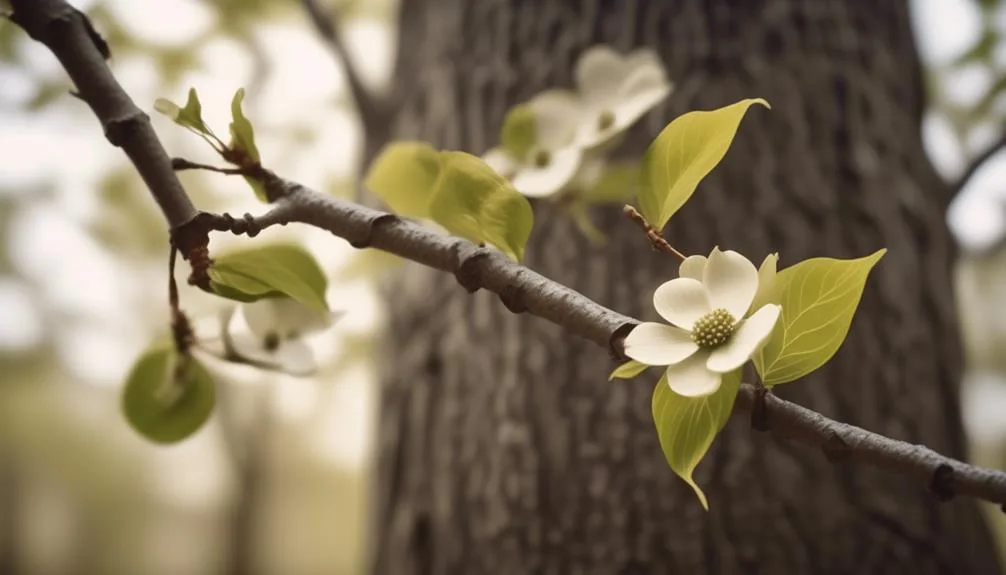Curious about grafting dogwood trees? It's not just for apples and roses.
Grafting dogwood trees can open up a world of new and unique varieties. Before taking on this challenge, there are important things to consider.
Whether you're an experienced gardener or new to plant propagation, understanding the ins and outs of grafting dogwood trees can bring exciting possibilities to your garden.
Grafting Dogwood Trees: Yes or No?
Grafting dogwood trees can be a beneficial technique for improving the health and vigor of your tree. When considering tree species for grafting, it's crucial to choose a compatible variety that will thrive in your specific climate and soil conditions. Some popular dogwood species for grafting include the Cornus florida and the Cornus kousa.
In terms of grafting tools and supplies, you'll need a sharp grafting knife, grafting tape, and a good quality grafting sealant to ensure successful grafting. It's important to ensure that your tools are clean and sharp to make precise cuts, which is essential for the success of the graft.
With the right tree species and the proper tools and supplies, grafting dogwood trees can be a rewarding and effective way to improve the overall health and resilience of your beloved tree.
How to Graft Dogwood Trees
To successfully graft a dogwood tree, begin by selecting a healthy and vigorous rootstock. Tree grafting methods and tree propagation techniques are essential to ensure a successful graft. Here's how to graft dogwood trees:
- Start by choosing a scion, which is a healthy and disease-free cutting from the dogwood tree you want to propagate.
- Make a slanting cut at the base of the scion and the rootstock to increase the contact area for better grafting.
- Secure the scion onto the rootstock using grafting tape or rubber bands to hold them firmly together.
- Keep the grafted area moist and protected from direct sunlight to promote successful fusion.
- Monitor the graft regularly to ensure it takes hold and begins to grow together.
Grafting dogwood trees requires precision and care, but with the right techniques, you can successfully propagate your favorite dogwood varieties.
Suitable Dogwood Grafting Techniques
Using the right tools and techniques is essential for successful dogwood grafting. When grafting dogwood trees, the budding technique is commonly used. This involves taking a bud from the desired variety and inserting it under the bark of a compatible rootstock.
To ensure a successful graft, make sure the bark is slipping, indicating that it can be easily separated from the wood. The cut should be made at an angle, and the bud should be inserted gently to avoid damage. Once the bud is in place, secure it with grafting tape to protect it while it heals.
It's important to keep the graft union protected from harsh weather conditions and to monitor the progress of the graft carefully. With the right techniques, you can successfully graft dogwood trees and enjoy the benefits of different dogwood varieties on a single tree.
Best Time for Grafting Dogwood Trees
After mastering suitable dogwood grafting techniques, timing is crucial for the successful grafting of dogwood trees. The best time for grafting dogwood trees is during the dormant season, typically in late winter or early spring. This is when the sap begins to flow, aiding in the healing of the graft.
Consider these important factors for the best time to graft dogwood trees:
- Temperature: Choose a time when temperatures are consistently cool to prevent stress on the newly grafted tree.
- Moisture: Graft during periods of adequate soil moisture to support the tree's recovery.
- Health: Ensure the tree is in good health before grafting to promote successful integration.
- Compatibility: Match the timing with the specific dogwood species for optimal compatibility.
- Aftercare: Plan the timing so that you can provide proper aftercare for the grafted tree.
Grafting at the right time brings benefits and minimizes challenges, ensuring successful integration and healthy growth.
Tips for Successful Dogwood Tree Grafting
For successful dogwood tree grafting, understanding the proper technique and tools is essential. Grafting techniques play a crucial role in the success of the procedure. Ensure that the scion (the part being grafted) and the rootstock are of similar diameters for a successful union. It's important to make clean cuts and match the cambium layers of the scion and the rootstock.
Timing is also critical; perform grafting during the dormant season for the best results. Factors contributing to successful grafting include using sharp, sterile tools, and providing proper aftercare. Avoid common mistakes such as using dull tools, mismatching cambium layers, or grafting during the wrong season.
If issues arise, troubleshoot by carefully examining the graft union and making adjustments as necessary for optimal results.
Conclusion
Incorporating grafting techniques and timing, dogwood trees can be successfully grafted to create new varieties and enhance their overall well-being. By following these methods, you can introduce grafted dogwood trees to your garden, enriching it with their beauty and advantages.
Remember to apply the recommended tips for a successful grafting process. Happy grafting, and may your grafted dogwood trees flourish in your landscape, adding diversity and vitality to your surroundings.

My interest in trees started when I first saw the giant sequoias in Yosemite.
I was a teenager then, and I remember thinking, “I need to learn more about this.”
That moment stuck with me.
A few years later, I went on to study forestry at Michigan Tech.
Since graduating, I’ve worked in a mix of hands-on tree care and community education.
I’ve spent over ten years helping people understand how to plant, maintain, and protect the trees in their neighborhoods.
I don’t see trees as just part of the landscape.
They are living things that make a real difference in our daily lives.
